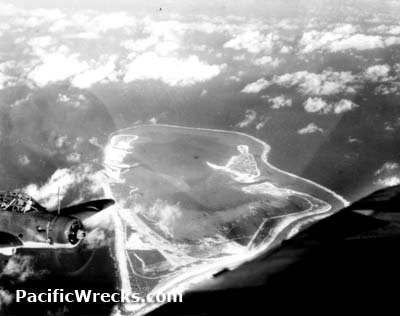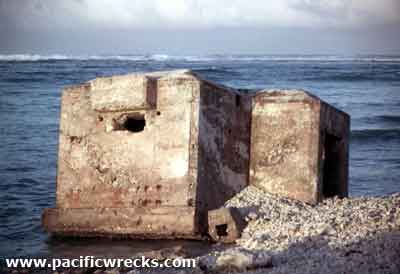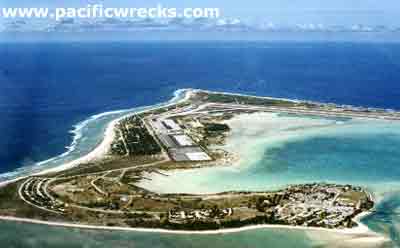|
|
|
|
| Missing In Action (MIA) | Prisoners Of War (POW) | Unexploded Ordnance (UXO) |
| Chronology | Locations | Aircraft | Ships | Submit Info | How You Can Help | Donate |
|
 IJN December 23, 1941  USN January 2, 1942  USN February 24, 1942  Kirby Crawford 1967  USN 2000 |
Location Wake Island is the largest island in Wake Atoll surrounded by the Pacific Ocean. Peacock Point is located on the southeast tip. Borders the lagoon to the northwest. The northern tip borders Peale Island and the western tip borders Wilkes Island. In 1899 the United States took possession of Wake Atoll. During the Japanese occupation renamed Otorishima (Otori Jima). Today Wake Island is unorganized, unincorporated territory and is considered part of the United States Minor Outlying Islands of the United States of America (USA). Prewar A causeway connected the northwest tip of Wake Island to the southeast tip of Peale Island. Another causeway connected the southwest tip of Wake Island to the southeast of Wilkes Island. Before the start of the Pacific War, Wake Island was developed with defenses in anticipation of a Japanese attack. Contractors Morrison-Knudsen Company, one of of eight construction companies that formed the Contractors Pacific Naval Air Bases (CPNB) built Wake Island Airfield. Defended by U.S. Marine Corps (USMC) 1st Defense Battalion. Wartime History On December 8, 1941 Japanese Type 96 / G3M2 Nells from Chitose Kōkūtai (Chitose Air Group) bomb Wake Island. Meanwhile a Japanese invasion force departs Kwajalien bound for Wake. On December 11, 1942 the Japanese attempt "U" Operation a landing on Wake but are repulsed by defending 5" gun batteries that score a hit and sinks Hayate and scores a hit on Yayoi that causes minor damage. Due to the strong defense, the Japanese invasion is suspended. While withdrawing, attacked by U.S. Marine Corps (USMC) F4F-Wildcats from VMF-211 that bomb and sink Kisaragi the first destroyer sunk with bombs dropped by a fighter aircraft. On December 23, 1941 during the early morning, the second Japanese invasion force arrives off Wake and Special Naval Landing Force (SNLF) troops make an amphibious landing. After almost 12 hours fighting, the U.S. garrison under the command of Commander Winfield S. Cunningham surrenders with 1,603 Americans becoming Prisoners Of War (POWs) including 1,150 civilian contractors employed by Morrison-Knudsen Company / Contractors Pacific Naval Air Bases (CPNB). Japanese missions against Wake Island December 8, 1941–December 23, 1941 Starting in February 1942 American planes begin flying reconassiance and strikes against Japanese occupied Wake. On February 14, 1942 a B-17 flies a reconassiance mission over Wake Island. On February 24, 1942 was the first Wake Island Raid by U. S. Navy (USN) Task Force 16 (TF-16) carrier planes from USS Enterprise (CV-6). On June 7, 1942 five LB-30s took off from Midway Airfield to bomb Wake but fail to find the target due to bad weather. On October 5, 1943 was the Second Wake Raid by by U. S. Navy (USN) Task Force 14 (TF 14) carrier planes that perform a two day strike against Wake. After these heavy air attacks, Japanese commander Admiral Sakaibara believed the raids was an indication that a U.S. invasion was imminent and ordered the execution of the 98 American prisoners "to eliminate any threat they might pose". For the remainder of the Pacific War, American planes targeted Wake including U.S. Navy carrier planes and U.S. Army Air Force (USAAF), 7th Air Force (7th AF) B-24 Liberators. American missions against Wake Island February 14, 1942–August 6, 1945 During the Japanese occupation, Wake Island was renamed Otorishima (Otori Jima) until the surrender of Japan. Before the arrival of American forces, the garrison exhumed the mass grave and the bones were moved to the U.S. cemetery on Peacock Point after the invasion marking them with wooden crosses. On September 4, 1945 the Japanese garrison at Wake Atoll surrendred to a detachment of U.S. Marines under the command of Brigadier General Lawson H. M. Sanderson aboard USS Levy (DE-162). During their initial interrogations, the Japanese claimed falsely that the remaining 98 Americans on the island were mostly killed by an American bombing raid, though some escaped and fought to the death after being cornered on the beach at the north end of Wake Island. Today The U.S. Coast Guard (USCG) maintained a station on Wake Island. During July 1969, Japanese chemical weapons in canisters began leaking a poison gas that was reportedly chloropicrin. As a result, several USCG personnel had to be evacuated. Wake Island Airfield Runs the length of the island, built by civilian contractors. Occupied by the Japanese until the end of the war. "98" Rock The "98 rock", a large piece of coral in the lagoon with "98/U.S./P.W/5-10-43" carved into the rock by one of the 98 civilian contractors detained on Wake Island. On October 5, 1943 after a heavy U.S. Navy air raid, the Japanese executed the 98 prisoners. One escaped and caved this message into the rock to memorialize the incident before he was tracked down and executed. The identity of the prisoner who made the carving is unknown. Command Posts and Fortifications Other significant remains include USMC command post and hospital bunkers, and the Japanese command post bunker. Numerous Japanese pillboxes, fighting positions, tank traps and aircraft revetments remain on the island. Peacock Point Located at the southeast tip of Wake Island. At this location, a gun battery was installed. References Naval History and Heritage Command (NHHC) - The Forsaken Defenders of Wake Island History of the Fifth Bomb Group: The Story of 5th Bombardment Group (Heavy) (1946) page 34 "Wake Island... On or about June 7 [1942] Colonel Waldron and crew of the 394th Squadron took part in a strike against Jap-held Wake Island. On this mission three enlisted men [Moeller, Scheid and Wagner] of the 394th were lost when they went down with General Clarence Tinker [aboard LB-30 Liberator AL589]. Another mission was performed by the Commanding Officer of the 31st Squadron Major George E. Gober. Major Gober and his crew flew almost halfway to Japan in making a photo reconnaissance of Wake Island. This single B-17 completely surprised the Japs, making to runs over the island before being attacked by six enemy fighters. In 40 minutes of a running fight four fo the Zero were shot down by the lone Fortress and one of the Zeros was probably destroyed. The B-7 [sic B-17] and its crew received slight damage only, and returned safely to the home base [Midway Airfield]. This reconnaissance produced the first picture of Wake Island made since the Pearl Harbor attack." New York Times "A Mysterious Irritant Forced Evacuation of Island in Pacific" July 4, 1969 "In July of 1969 'Japanese WWII' canisters began leaking gas, reportedly containing chloropicrin. Several members of the US Coast Guard station there were sickened by the gas and the area was evacuated." To Wake Island and Beyond Reminiscences (1988) by Woodrow M. Kessler [PDF] YouTube - Wake Island driving/walking tour (October 2015) Contribute
Information Last Updated
|
Map Fallingrain View in Google Earth Photo Archive |
| Discussion Forum | Daily Updates | Reviews | Museums | Interviews & Oral Histories |
|